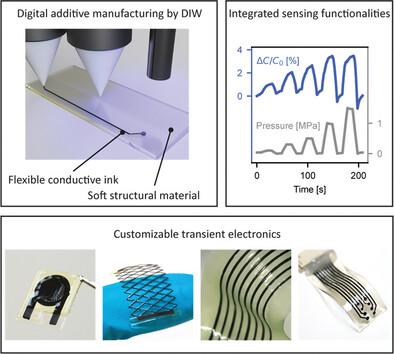当前位置:
X-MOL 学术
›
Adv. Electron. Mater.
›
论文详情
Our official English website, www.x-mol.net, welcomes your feedback! (Note: you will need to create a separate account there.)
3D Printing of Customizable Transient Bioelectronics and Sensors
Advanced Electronic Materials ( IF 5.3 ) Pub Date : 2024-06-27 , DOI: 10.1002/aelm.202400058 Nicolas Fumeaux 1 , Danick Briand 1
Advanced Electronic Materials ( IF 5.3 ) Pub Date : 2024-06-27 , DOI: 10.1002/aelm.202400058 Nicolas Fumeaux 1 , Danick Briand 1
Affiliation

|
Transient electronics have emerged as a new category of devices that can degrade after their functional lifetime, offering tremendous potential as disposable sensors, actuators, wearables, and implants. Additive manufacturing methods represent a promising approach for patterning transient materials, yet examples of fully printed bioelectronic devices are scarce. This study introduces a fully digital 3D printing approach enabling the prototyping and customization of soft bioelectronics made of transient materials. The direct ink writing of poly(octamethylene maleate (anhydride) citrate) (POMaC) as an elastomeric matrix and of a shellac‐carbon ink as a conductor is investigated. Precise and repeatable deposition of both structural and conductive features is achieved by optimizing printing parameters, i.e., the dispense gap, printing speed, and inlet pressure. Multi‐material 3D printing enables the fabrication of functional transient devices. Notably, pressure and strain sensors are shown to operate in ranges relevant to implanted biomechanical monitoring. 3D‐printed transient electrodes are demonstrated to be comparable to state‐of‐the‐art devices in terms of impedance behavior. Finally, physical degradation of the materials is confirmed at physiological conditions. These fully digital additive manufacturing processes enable the monolithic fabrication of customizable transient bioelectronics with adaptable functions and geometries.
中文翻译:

可定制瞬态生物电子学和传感器的 3D 打印
瞬态电子器件已成为一类新的设备,在其使用寿命结束后会降解,为一次性传感器、执行器、可穿戴设备和植入物提供了巨大的潜力。增材制造方法代表了一种有前途的瞬态材料图案化方法,但完全印刷的生物电子设备的例子却很少。这项研究引入了一种全数字 3D 打印方法,可以对由瞬态材料制成的软生物电子器件进行原型设计和定制。研究了聚(马来酸八亚甲基(酸酐)柠檬酸酯)(POMaC)作为弹性体基质和虫胶碳墨水作为导体的直接墨水书写。通过优化印刷参数(即分配间隙、印刷速度和入口压力),可以实现结构和导电特征的精确且可重复的沉积。多材料 3D 打印可以制造功能性瞬态器件。值得注意的是,压力和应变传感器被证明可以在与植入生物力学监测相关的范围内运行。 3D 打印瞬态电极被证明在阻抗行为方面可与最先进的设备相媲美。最后,在生理条件下证实了材料的物理降解。这些全数字增材制造工艺能够实现具有适应性功能和几何形状的可定制瞬态生物电子器件的整体制造。
更新日期:2024-06-27
中文翻译:

可定制瞬态生物电子学和传感器的 3D 打印
瞬态电子器件已成为一类新的设备,在其使用寿命结束后会降解,为一次性传感器、执行器、可穿戴设备和植入物提供了巨大的潜力。增材制造方法代表了一种有前途的瞬态材料图案化方法,但完全印刷的生物电子设备的例子却很少。这项研究引入了一种全数字 3D 打印方法,可以对由瞬态材料制成的软生物电子器件进行原型设计和定制。研究了聚(马来酸八亚甲基(酸酐)柠檬酸酯)(POMaC)作为弹性体基质和虫胶碳墨水作为导体的直接墨水书写。通过优化印刷参数(即分配间隙、印刷速度和入口压力),可以实现结构和导电特征的精确且可重复的沉积。多材料 3D 打印可以制造功能性瞬态器件。值得注意的是,压力和应变传感器被证明可以在与植入生物力学监测相关的范围内运行。 3D 打印瞬态电极被证明在阻抗行为方面可与最先进的设备相媲美。最后,在生理条件下证实了材料的物理降解。这些全数字增材制造工艺能够实现具有适应性功能和几何形状的可定制瞬态生物电子器件的整体制造。
















































 京公网安备 11010802027423号
京公网安备 11010802027423号